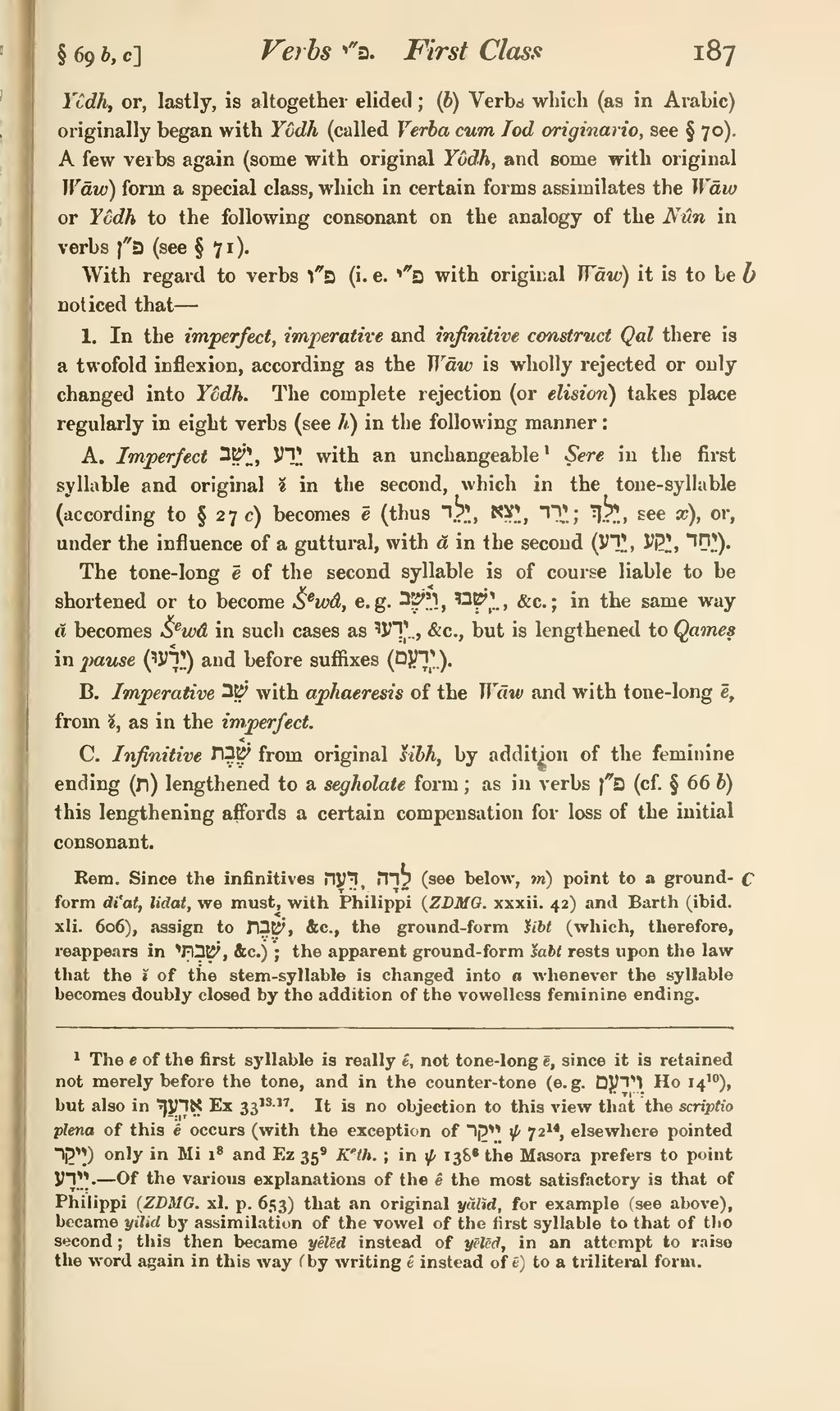Yôdh, or, lastly, is altogether elided; (b) Verbs which (as in Arabic) originally began with Yôdh (called Verba cum Iod originario, see § 70). A few verbs again (some with original Yôdh, and some with original Wāw) form a special class, which in certain forms assimilates the Wāw or Yâdh to the following consonant on the analogy of the Nûn in verbs פ״ן (see § 71).
[b] With regard to verbs פ״ו (i.e. פ״י with original Wāw) it is to be noticed that—
1. In the imperfect, imperative and infinitive construct Qal there is a twofold inflexion, according as the Wāw is wholly rejected or only changed into Yôdh. The complete rejection (or elision) takes place regularly in eight verbs (see h) in the following manner:
A. Imperfect יֵשֵׁב, יֵדַע with an unchangeable[1] Ṣere in the first syllable and original ĭ in the second, which in the tone-syllable (according to § 27 c) becomes ē (thus יֵלֵד, יֵצֵא, יֵלֵךְ ;יֵרֵד, see x), or, under the influence of a guttural, with ă in the second (יֵדַע, יֵקַע, יֵחַד).
The tone-long ē of the second syllable is of course liable to be shortened or to become Šewâ, e.g. וַיֵּ֫שֶׁב, יֵֽשְׁבוּ, &c.; in the same way ă becomes Šewâ in such cases as יֵֽדְעוּ, &c., but is lengthened to Qameṣ in pause (יֵדָ֫עוּ) and before suffixes (יֵֽדָעֵם).
B. Imperative שֵׁב with aphaeresis of the Wāw and with tone-long ē, from ĭ, as in the imperfect.
C. Infinitive שֶׁ֫בֶת from original šibh, by addition of the feminine ending (ת) lengthened to a segholate form; as in verbs פ״ן (cf. § 66 b) this lengthening affords a certain compensation for loss of the initial consonant.
[c] Rem. Since the infinitives דֵּעָה, לֵדָה (see below, m) point to a ground-form diʿat, lidat, we must, with Philippi (ZDMG. xxxii. 42) and Barth (ibid. xli. 606), assign to שֶׁ֫בֶת, &c., the ground-form šibt (which, therefore, reappears in שִׁבְתִּי, &c.); the apparent ground-form šabt rests upon the law that the ĭ of the stem-syllable is changed into a whenever the syllable becomes doubly closed by the addition of the vowelless feminine ending.
- ↑ The e of the first syllable is really ê, not tone-long ē, since it is retained not merely before the tone, and in the counter-tone (e.g. וְיֵדָֽעֵם Ho 14), but also in אֵדָֽעֲךָ Ex 33. It is no objection to this view that the scriptio plena of this ê occurs (with the exception of יֵיקַר ψ 72, elsewhere pointed יִיקַר) only in Mi 1 and Ez 35 Keth.; in ψ 138 the Masora prefers to point יְיֵדָע.—Of the various explanations of the ê the most satisfactory is that of Philippi (ZDMG. xl. p. 653) that an original yălĭd, for example (see above), became yilid by assimilation of the vowel of the first syllable to that of the second; this then became yêlēd instead of yēlēd, in an attempt to raise the word again in this way (by writing ê instead of ē) to a triliteral form.
